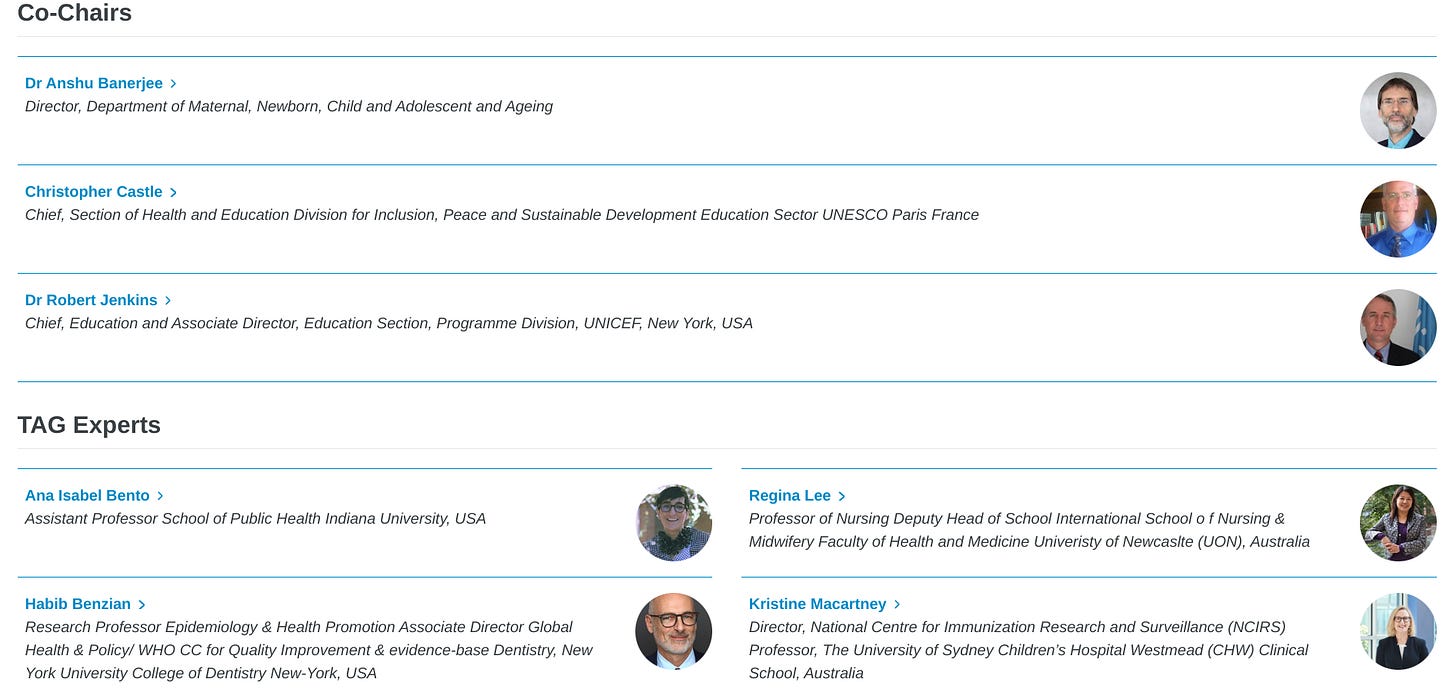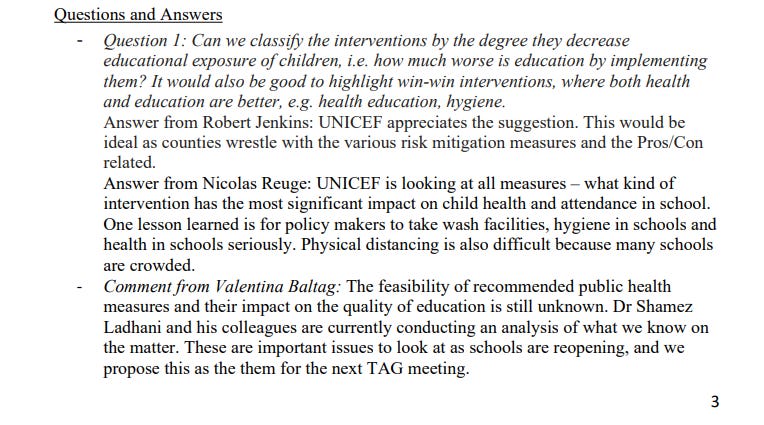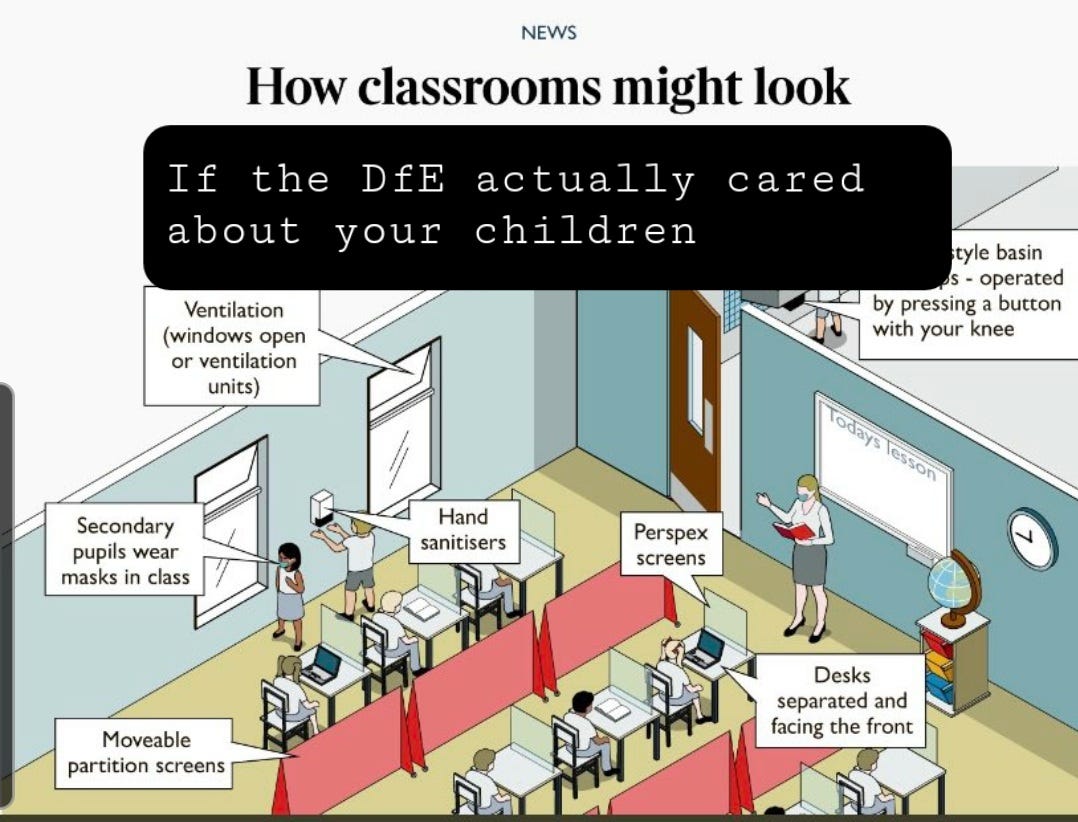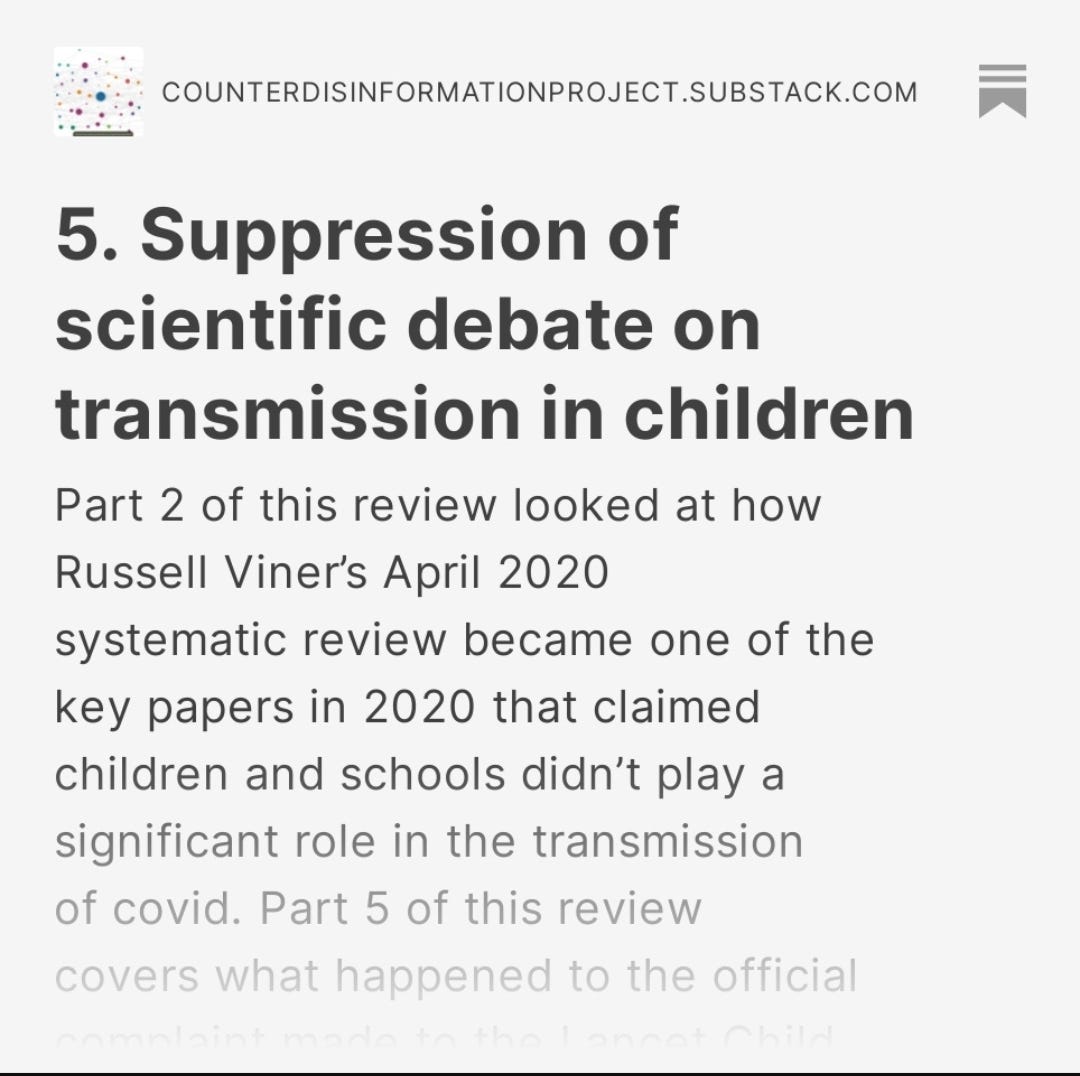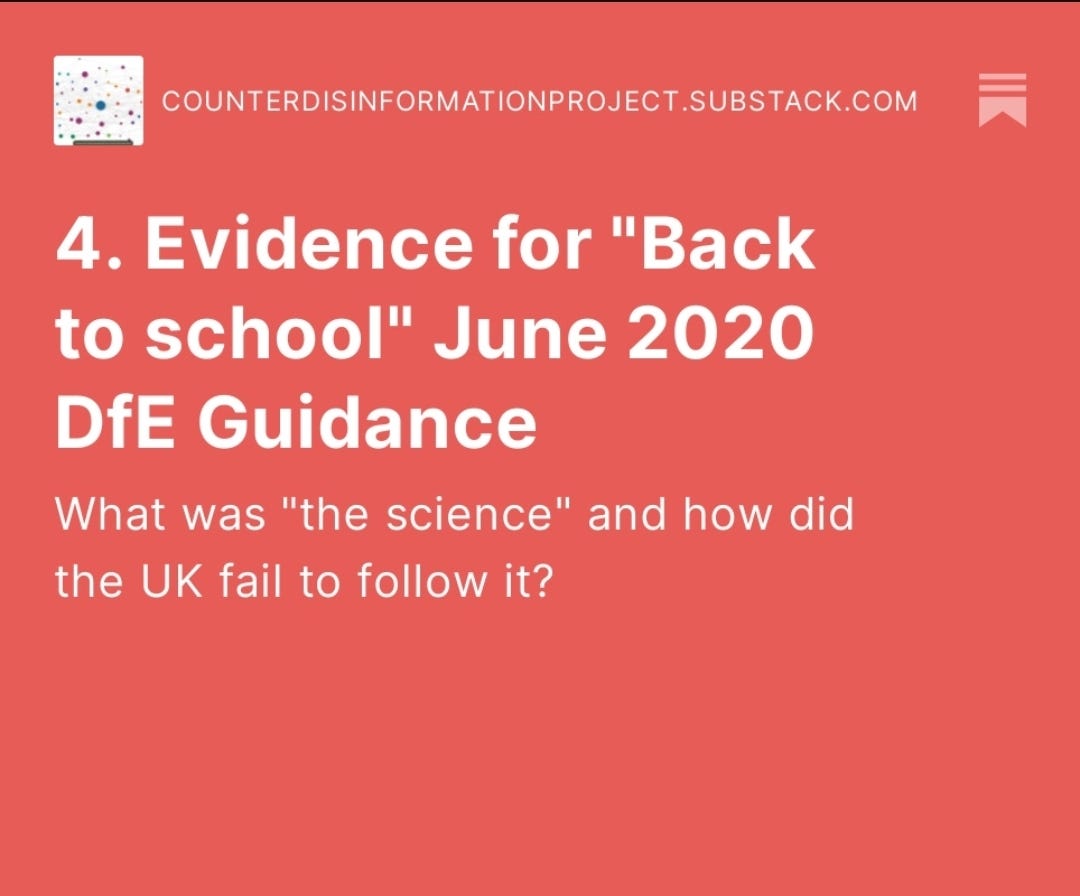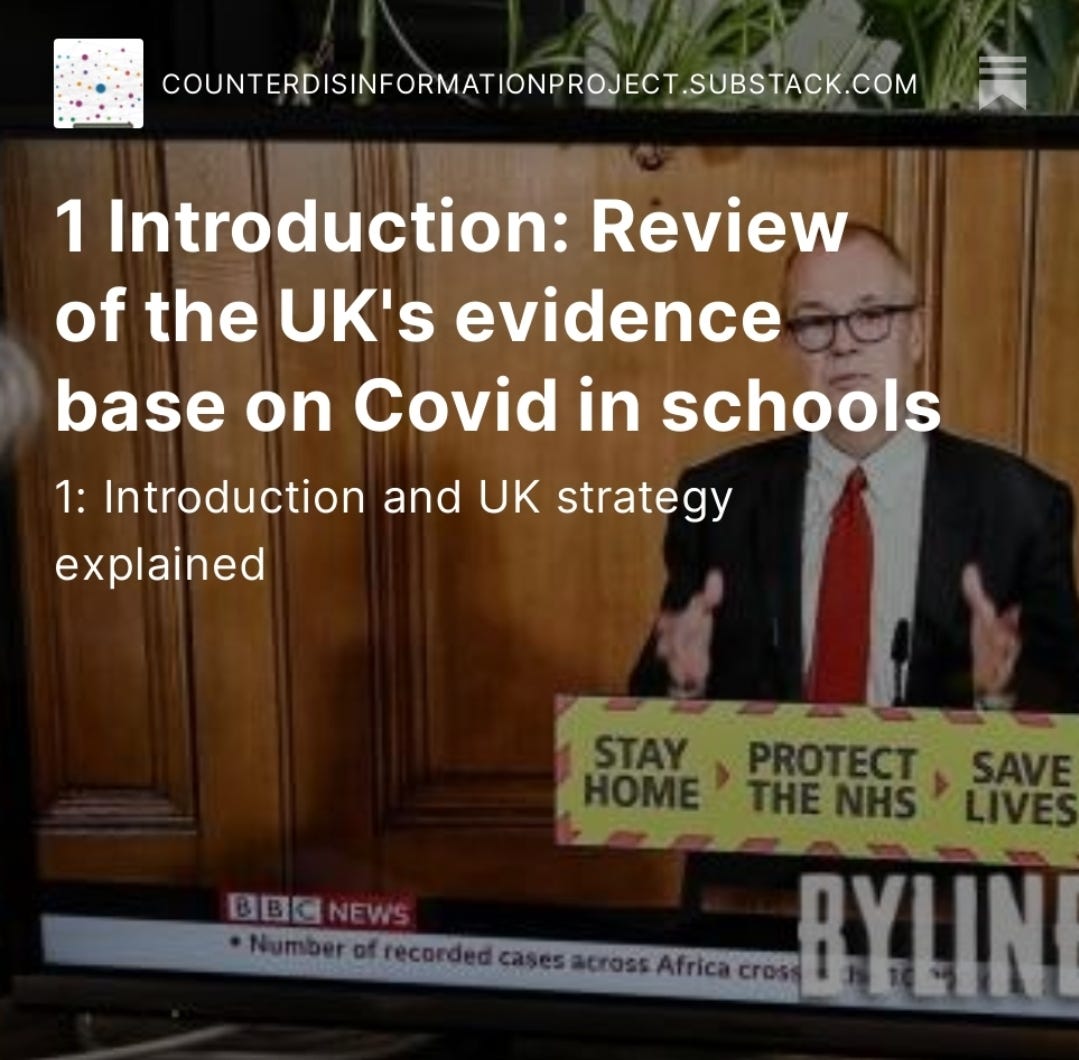9. June - Oct 2020: UK influence on WHO Schools groups
Different advisory groups, same advisors
Previous parts of this review of the evidence base behind the UK’s policy on covid in children and schools have examined how the few individuals who became the UK’s key paediatric advisers have sought to influence the evidence base and policy of other countries, for instance the US via email exchanges with Fauci to set up colloboration projects and with European countries via the ESPID organisation.
Part 8 of the review will cover the UK’s influence on WHO advisory groups focused on reopening schools after the first lockdown.
Technical Advisory Group (TAG) of Experts on Educational Institutions and COVID-19
The WHO set up the Technical Advisory Group (TAG) of Experts on Educational Institutions and COVID-19 which had its inaugural meeting on 30 June 2020. The focus of the group was on how to safely reopen schools. The starting point of the group’s understanding of covid in children was Russell Viner’s April 2020 systematic review that concluded that schools and children didn’t play a significant role in transmission.
It would be interesting to know the decision making process that led the WHO chose a paper that mainly relied on studies of other viruses rather than more recent studies.
The advisory group was designed to build on the “emerging knowledge” provided by Viner. Under the premise of covid continuing to circulate for the immediate future, the focus was on returning children to school for their well-being and “the need to free up parents to be able to get back to their previous work levels.” There is a general assumption that managing transmission is more of an issue than harm to children from covid.
The group set out the key questions to answer,
TAG’s members were drawn from three existing advisory groups,
Full membership
The US, UK and Australia make up 12 of the 18 TAG Experts, this includes Viner and Ladhani.
The first meeting set out the terms of the groups, the second began with a discussion regarding the concerns of education workers. The main issue identified was a lack of trust in governments, designating teachers frontline workers and providing better access to testing was suggested as a solution.
The third meeting was on 19 August. Russell Viner presented on behalf of the Research Network, setting out a draft document on how data on covid in children and schools should be interpreted.
Many of the recommendations including those regarding how studies were likely to underestimate cases in children were not applied to the results of many studies in the UK when communicated to the media.
The discussion on the feasibility of various measures concluded with waiting for Ladhani to present analysis at the next meeting.
Throughout the WHO meetings there is a large focus on hand washing and hygiene when measures are discussed.
WHO Technical Advisory Group on schooling during COVID-19
The Technical Advisory Group on schooling during COVID-19 was established by the WHO’s European region in the summer of 2020, as the result of a high priority meeting requested by Italy.
The first meeting was on 27 October, however a document was published on 14 September.
The aim of this document is on aiding policy makers in their efforts to make their societies learn to live with the “new normal”.
The document states there is limited evidence schools are driving transmission, deviating from the common script at the time that they didn’t play a significant role.
There is lots of detail on how public health and local services should collaborate to support students and schools, and suggestions on how to gather the best practice for remote education. The general principle is that measures should be kept to a minimum where possible and be ramped up in line with local transmission levels.
There are many similarities to the Containment Framework published by the DfE at the end of August that was an extension of the Tier system, however the framework was never implemented, even in areas which were seeing large outbreaks and high community transmissions as the Alpha variant gained dominance.
Full membership of the European group
The UK has the most members which includes Viner and Ladhani. One member of particular note is Anders Tegnell who led Sweden’s response.
17 September - Technical Advisory Group (TAG) of Experts on Educational Institutions and COVID-19 4th meeting
The first point of new business was a presentation by Ladhani that concluded that while children are infected, this doesn’t appear to be occurring in schools.
Next came a presentation from another UK expert, Sundaram, demonstrating how UK data often led WHO discussions. Its likely that the UK’s expertise in life sciences research combined with the benefits of accurate population wide data due to the NHS meant it was considered to be one of the most reliable countries to be used as a case study. In September UK schools were amongst those with the least mitigations, some government advisers even admitted a gamble was being taken leading to accusations of children being treated like lab rats.
While the presentation concluded that implementing many measures had proven practically difficult, the return of all students was seen as a success.
“What makes a difference is really wanting the kids to come back. You set the tone, use a common sense and pragmatic approach and you need to inspire confidence.” As explained in previous parts of this review public confidence was gained through a media campaign that suggested children didn’t contribute to transmission and that many measures would be properly implemented.
In the discussion that follows the current situation in UK schools is described as in a “precarious position”, “We will have to ride through this every couple of weeks and see where we are. Right now, it is pretty rough”, however it was suggested that testing every sneeze was creating panic in staff and parents. Children were said to get very robust antibody responses.
This seems at odds with the claim at the time by Ladhani that there hadn’t been a significant rise in cases at the start of September after schools returned. A couple of days after this meeting the UK government would decide to ignore SAGE’s recommendations for a circuit breaker lockdown due to rapidly rising cases.
The meeting then had a research update from Viner who appears to have taken the role of representing the WHO’s research network at the meetings.
19 October - Technical Advisory Group (TAG) of Experts on Educational Institutions and COVID-19 5th meeting
The group proposes to create a UNICEF working group to guide policy makers because politicians and the public “do not always have the analytical capacity to critically review and engage with the scientific research.” The aim is to “mitigate the impact of misinformation” principally that schools could play a significant role in transmission as the group know acknowledged “lack of correlation between opening/closing of schools”.
The documents produced by this working group was endorsed by major international organisations.
There was concern by Navarro from UNICEF that the first draft advised closing schools early, he requested TAG members support in redrafting, many members agreed with some suggesting the need to focus on a narrative of community transmission.
UNICEF’s major concern was that “misinformation of the supposed correlation between school reopening and community is spreading” which suggests the evidence of experts such as from the UK and Sweden had successfully dismissed the notion that transmission was an issue in schools. The WHO TAGs then fed this evidence base directly to governments and also a number of international organisations via UNICEF.
Next item at the meeting, the Research Network provides an update for Viner’s latest review.
A paper mentioned in various UK advisory committees on suicide is also mentioned, as is another paper that calculated learning loss as permanent and suggesting this would impact the lifetime earnings and health of a quarter of the workforce by 2030.
Official statistics later showed that the suicide rate in teens had fallen during lockdown before rising again once schools returned.
Two other items were discussed at the meeting.
26 October: First meeting of the Technical Advisory Group on Safe Schooling During the COVID-19 Pandemic
The WHO European group met for the first official meeting on 26 October.
The work of this TAG was to produce recommendations for meetings with the representatives of European governments.
Summary of Round 1 of presentations
There was agreement that cases had risen with schools reopening, there was also agreement that schools weren’t responsible for these rises.
Piers Mook (Infectious Hazards Management, WHO Regional Office for Europe) on transmission, COVID-19 is reported much less frequently in children than in adults, Staff-to-staff transmission is more common than student-tostaff or student-to-student transmission. Children with underlying conditions are at higher risk of serious illness.
Florian Götzinger (Department of Paediatric and Adolescent Medicine, National Reference Centre for Childhood Tuberculosis, Wilhelminenspital, Vienna, Austria) gave a presentation on severe disease in children. Children with comorbidities and with co-infections therefore seem more prone to severe infection that requires further specialised care.
Walter Haas (Head of Respiratory Infections, Robert Koch Institute, Germany) addressed the impact of school closures on the wider population. He provided evidence that when schools reopened incidence among school-aged children and adolescents tripled compared to the situation during the summer holidays but concluded this data suggested “children and adolescents are followers, not drivers, of the pandemic, with a slower dynamic in younger children.” Recommended a focus on testing to keep schools open.
Jonathan Suk (ECDC) elaborated on SARS-CoV-2 transmission in household and school settings. COVID-19 incidence in children under 15 years of age is increasing (7%) compared to the situation before schools were reopened (5%), but cited surveillance suggesting children were less likely to be an index case, concluding “school closure therefore is not assumed to be an effective measure for controlling spread of COVID-19.”
Summary of Round 2 presentations
Kayla King (consultant, WHO Regional Office for Europe) and Ihor Perehinets (Acting Programme Area Manager, Country Health Emergency Preparedness and International Health Regulations (IHR) (2005), WHO Regional Office for Europe) introduced the measures being collected in the European Region.
Eva Rehfuess (Ludwig-Maximilians University, Munich, Germany) presented the preliminary results of a Cochrane scoping review of measures implemented in school settings. These results are not included in the meeting’s report.
Martin Weber (Programme Manager, Child and Adolescent Health and Development, WHO Regional Office for Europe) presented a matrix table that considers the impact of COVID-19 control measures in school settings on children. The matrix is not included in the meeting’s report.
Antony Morgan (Chair of the TAG) introduced the work of the COVID-19 Maternal, Newborn, Child and Adolescent Health Research Network initiated by WHO headquarters. These groups had been merged. The working group brings people conducting research on COVID-19 and education institutions together to share information, set priorities for future research, and feed knowledge into WHO and United Nations Educational, Scientific and Cultural Organisation (UNESCO) guidance processes.
Unlike Round 1 he meeting’s minutes do not include details on the discussion on the presentations. With the results of several of the studies cited not included there is a hole in the minutes in regards to what measures would be recommended to policy makers.
The study presented by Ladhani appears to be the School’s Infection Survey. This study only tested those who were in school on the day of testing, those isolating due to having tested positive were not included in the results.
The TAG concludes that school are not drivers of infection and school closures should not be considered a single effective measure for controlling transmission. Mass testing was considered unfeasible with suggested testing should focus on vulnerable groups. How would testing vulnerable people protect them from infection, surely all this does is identify the individuals who haven’t been protect from infection? There is a focus on the harms of measures on vulnerable students but not the harms of covid.
Both annexes listed in the comments are blank in the published report.
Summary
The WHO TAG’s consist primarily of government experts. A large number of TAG members are UK based and UK data and studies provided the starting point for many discussions. There is almost no documented disagreement between members of TAGs. Long covid wasn’t discussed during this period of time, the benefits of clean air are not discussed beyond the occasional mention of opening a window, the main focus for mitigations was cleaning and hygiene; another example of the WHO’s failure to recognise airborne transmission. Potential long term harms of infection and repeat reinfection weren’t discussed in these meetings.
Building on previous parts of this review this section shows how certain key but controversial UK papers like Viner’s April 2020 systematic review became one of the most cited papers that year on transmission in children. Many UK documents and institutions used the paper as a reference, via emails with Fauci setting up collaboration projects the paper became widely cited in North America, ESPID produced papers in Europe based on Viner’s paper, and with the paper being presented to the WHO TAGs it also came to be a trusted source by many international organisations.
The UK government’s experts could claim consensus supported them by quoting international documents they’d help draft which quoted themselves. It became possible to produce a document claiming schools didn’t contribute to transmission citing what appeared to be a wide range of institutions PHE, RCPCH, ESPID, WHO TAGs, UNICEF, UN agencies etc when in reality they all relied on the same narrow evidence base. This was compounded as national and federal governments were fed the same evidence base to include in their own documents.
As those working with the UK government acted as gatekeepers curating the evidence base in regards to which studies should be seen as reliable and which should be dismissed, the membership of the TAGs had the opportunity to do the same internationally. This would explain the convergence of narratives and policies across many countries, particularly in North America and Europe based on a relatively small evidence base produced by a narrow selection of experts.
Part 10 will cover how these TAGs responded as cases continued to rise in many countries leading to winter lockdowns as the Alpha variant came to dominance and vaccines were approved for roll out.
8. Autumn 2020: How contact testing in UK schools collapsed
This is a previous article reprinted as part of the Review of the UK's evidence base on Covid in schools. Recent attempts at revisionism are suggesting schools could have continued operating normally throughout lockdowns without disruption, this stance fails to acknowledge that schools faced continuous disruption for two years. Education is still struggl…
7. Why did the UK ignore calls for a September circuit breaker?
13 May
6. Who wrote the September 2020 schools guidance?
COUNTER DISINFORMATION PROJECT
·
26 APR
5. Suppression of scientific debate on transmission in children
COUNTER DISINFORMATION PROJECT
·
16 APR
4. Evidence for "Back to school" June 2020 DfE Guidance
COUNTER DISINFORMATION PROJECT
·
13 APR
3. UK Influence: Viner, Farrar, Fauci emails & ESPID
COUNTER DISINFORMATION PROJECT
·
9 APR
2. March - April 2020 "No child is known to have passed on Covid-19 to an adult"
COUNTER DISINFORMATION PROJECT
·
3 APR
1.Introduction: Review of the UK's evidence base on Covid in schools
COUNTER DISINFORMATION PROJECT
·
30 MAR








